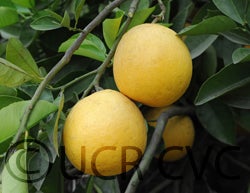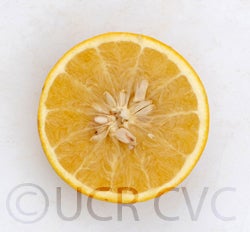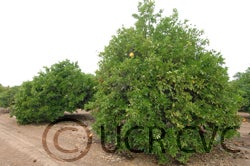Citrus paradisi Macfadyen
CRC 2885
PI 539468
Source
Received as budwood from New Zealand, 1943.
Parentage/origins
This variety originated as a chance seedling at Wheeny Creek near Kurrajong, New South Wales, Australia, and was named by R. J. Benton, government citrus specialist.
Rootstocks of accession
Carrizo citrange, C-35 citrange
Season of ripeness at Riverside
January to May
Notes and observations
WPB: Introductory tree pulled from nursery- new trees budded on Troyer citrange. Fruit has excellent flavor, no bitter taste. Seed is monoembryonic. While the fruit is grapefruit-like in most respects, the monembryonic nature of its seeds and some of the other characters suggest that it is probably a pummelo hybrid.
RRK: Excellent flavor, no bitter taste. Trees breaking from enormous crop load, but fruit still relatively good size; very seedy, has large hollow core, flesh lighter in color than other seedy white grapefruit.
6/10/2009, DK & TS: Very sour.
Description from The Citrus Industry Vol. 1 (1967)
"Fruit large, oblate or very broadly obovate to globose; both ends depressed, with small radially-furrowed basal cavity and broad, shallow apical basin; moderately seedy but monoembryonic. Color pale to light yellow. Rind medium-thin with moderately rugose surface (not smooth as are most grapefruits). Flesh straw-colored; coarse textured but very juicy; flavor good but acid (virtually indistinguishable from some grapefruits). Medium-early in maturity (as compared to the true grapefruits).
Tree vigorous, spreading, large, and productive with tendency to alternation in bearing. Leaves longer and more pointed than most grapefruits and somewhat bullate (puckered), with comparatively narrow petiole wings.
A lower total heat requirement than for grapefruit is indicated by the fact that in both New Zealand and coastal southern California Wheeny ripens satisfactorily in climates too cool for any of the true grapefruits. Under conditions favorable to grapefruit, it matures earlier and develops quality equal or superior to many grapefruit varieties.
This variety originated as a chance seedling at Wheeny Creek near Kurrajong, New South Wales, Australia, and was named by R. J. Benton, government citrus specialist. It is of principal importance in New Zealand, however, where it was introduced about 1935 and now constitutes about 15 per cent of the so-called grapefruit acreage, the balance being provided by the New Zealand Grapefruit or Poorman Orange. Under heat-deficient climatic conditions in Australia and New Zealand, Wheeny is a summer-maturing variety.
While the fruit is grapefruit-like in most respects, the monoembryonic nature of the seeds and some of the other characters suggest that it is probably a pummelo hybrid.
Availability
Not commercially available in California.
USDA Germplasm Resources Information Network page for Wheeny grapefruit



